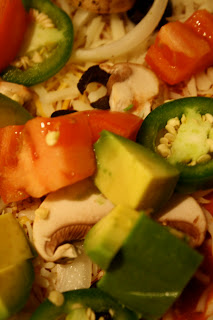Kimchi seems to be one of those foods that people either love (with a passion) or hate (with a passion). I am on the loving front. I was first introduced to Korean food about 15 years ago, when I took piano lessons in Rockville, MD. In the same plaza as the piano store, there was a little Korean restaurant we used to go to after lessons. I don't know the real name of the restaurant, and it is unfortunately no longer there. My family called the restaurant "noodle man" because there was a window into the kitchen where we used to watch a man make noodles. It was here that I first fell in love with Korean food.
One of the staples of Korean food is kimchi. Kimchi comes in many varieties, but is most frequently (in my American experience at least) spicy pickled cabbage. It can be bought in Korean grocery stores for just a few dollars, or in American grocery stores for much more. Inspired by the sale on cabbage (30 cents/pound!), I decided to take a stab at making my own kimchi, using a spice packet from an Asian supermarket.
The first step was to soak the vegetables (cabbage and radishes) overnight in salt water.
The next morning, I rinsed the vegetables and mixed them with the spice packet. Then, I put them back in the refrigerator to cure for two more days.
As you can see, while curing the vegetables shriveled up, taking up about 2/3 of their original space.
The kimchi smelled spot-on, spicy and tangy. However, after tasting the kimchi, I realized that my calculations were off. I used twice as much salt in the first soak as was recommended. The kimchi turned out extremely salty. I will have to try this again, paying closer attention to the instructions.
To make up for my failed kimchi, I decided to try my hand at another Korean dish: japchae. Contrary to many people's preconceived notions, not all Korean food is spicy. Japchae is a pretty mild noodle and vegetable dish. The first step in making my japchae was to boil noodles. Traditionally, japchae is made with sweet potato noodles. I did not have any sweet potato noodles, nor have I ever seen any sweet potato noodles, so I used mung bean noodles instead. Rice noodles would work fine as well.
While the noodles were cooking, I cut up the vegetables I had on hand: green bell pepper, scallions, and onion, along with some tofu. This was not the most exciting vegetable combination ever. If I had planned to cook this dish, I would have picked up more vegetables. While I do not know what vegetables traditionally go into japchae, I think that mushrooms, peppers, snap peas, carrots, or any other colorful vegetable would go well in this dish.
In a large pan, I sauteed the vegetables with garlic in olive oil (obviously), sesame oil and soy sauce. After the noodles were cooked, I drained them and tossed them in sesame oil and soy sauce, and added a little raw cane sugar. Then, I combined the noodles with the vegetables in the large pan and added even more sesame oil and soy sauce.
The recipe I used, modified from a post on
www. herbivoracious.com, created a ton of food. I happily had japchae for lunch most of the week. It was especially good when spiced up with some sriracha!






























